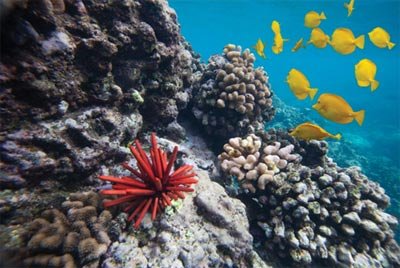About Adaptation Design for Coral Reef Restoration
About Adaptation Design for Coral Reef Restoration
Coral reefs - which provide valued ecosystem services such as fisheries, coastal protection, and tourism—are threatened by the effects of increased sea surface temperatures, sea level rise, and intensifying storms. These large-scale stressors are interacting with local stressors such as pollution, overfishing, and recreational misuse to drive ongoing and accelerating declines in coral reef ecosystems.

Thus, there is a need to design and implement climate change adaptation measures that will enable reef resilience in the face of these changes. This includes accounting for, and adjusting to, the combined effects of climate change and local stressors in coral reef restoration efforts.
The Action Plan for Restoration of Coral Reef Coastal Protection Services presents a hypothetical coral reef restoration project, located in the Pacific region, with a focus on the goal of improving the ecosystem service of coastal protection. It demonstrates a structured process for integrating the climate-smart design principles of the Adaptation Design Tool into restoration planning using A Manager’s Guide to Coral Reef Restoration Planning and Design. The Guide was created to aid coral reef managers in developing restoration projects for coral reefs in their locations and includes a workbook that can be used to document the information assessed and decisions made to create a restoration action plan.
The action plan, example case study, and workbook in the Action Plan for Restoration of Coral Reef Coastal Protection Services, provide Guide users with a completed example of how to use the workbook to inform a draft action plan, centering on the topic of coastal protection as a burgeoning area of interest in coral reef science and management communities. As a hypothetical case study, it creates a starting point for more detailed planning that would occur in specific places. The workbook, together with the action plan, also can serve as a valuable record of the planning thought process and a living document for adaptive management, to be updated through time as improved information becomes available.
History
Below is a list of important milestones for Adaptation Design for Coral Reef Restoration.
| Date | Milestone |
|---|---|
| Jun 2022 | Final report provided on the Global Climate Explorer (GCX) website |
| Jan 2022 | Final report released online |
| Oct 2021 | External peer review completed |
| Mar 2021 |
Internal peer review completed |
| Sep 2020 | Project kickoff |
Publications
Reports
- U.S. EPA. 2022. Action Plan for Restoration of Coral Reef Coastal Protection Services: Case Study Example and Workbook, Supplement to A Manager’s Guide to Coral Reef Restoration Planning & Design. U.S. Environmental Protection Agency, Washington, DC, EPA/600/R-21/306.
Related Publication
- Shaver E.C., Courtney C.A., West J.M., Maynard J., Hein M., Wagner C., Philibotte J., MacGowan P., McLeod I., Boström-Einarsson L., Bucchianeri K., Johnston L., Koss J. 2020. A Manager’s Guide to Coral Reef Restoration Planning and Design. NOAA Coral Reef Conservation Program. NOAA Technical Memorandum CRCP 36, 128 pp.
Online Training
- Free, self-paced online training: (See “Introduction to Restoration and Project Planning” for training on how to use A Manager’s Guide to Coral Reef Restoration Planning and Design)
